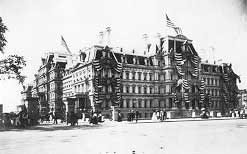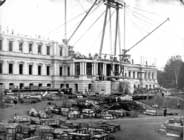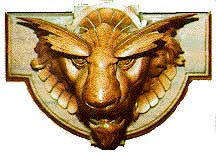Tours
Presidents & First Ladies
White House
Events & Traditions
- African-American History Month
- Presidents & Baseball
- Grounds and Garden
- Easter Egg Roll
- Christmas & Holidays
- State of the Union
Resources
Military
|
Home >
History & Tours >
Eisenhower Executive Office Building
|

Historical View of the EEOB — The 1800's
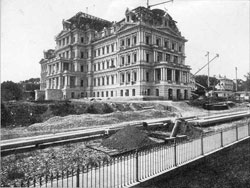 Construction of the south and east wings, July 1, 1874. With the State Department wing nearing completion, work began on the foundations for the Navy, east wing. National Archives Records Administration. 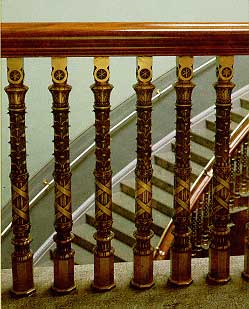 Bronze stair balusters for the State Department, south wing. Walter Smalling, Jr. In December of 1869, Congress appointed a commission to select a site and prepare plans and cost estimates for a new State Department Building. The commission was also to consider possible arrangements for the War and Navy Departments. To the horror of some who expected a Greek Revival twin of the Treasury Building to be erected on the other side of the White House, the elaborate French Second Empire style design by Alfred Mullett was selected, and construction of a building to house all three departments began in June of 1871. Construction took 17 years as the building slowly rose wing by wing. When the EEOB was finished in 1888, it was the largest office building in Washington, with nearly 2 miles of black and white tiled corridors. Almost all of the interior detail is of cast iron or plaster; the use of wood was minimized to insure fire safety. Eight monumental curving staircases of granite with over 4,000 individually cast bronze balusters are capped by four skylight domes and two stained glass rotundas. 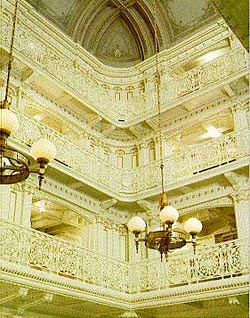
The Executive Office of the President Library was originally the State Department's Library. This room was constructed entirely of cast iron in 1875. Walter Smalling, Jr. The Navy Department moved into the east wing in 1879, where elaborate wall and ceiling stenciling and marqetry floors decorated the office of the Secretary. The Indian Treaty Room, originally the Navy's library and reception room, cost more per square foot than any other room in the building because of its rich marble wall panels, tiled floors, 800-pound bronze sconces, and gold leaf ornamentation. This room has been the scene of many Presidential news conferences and continues to be used for conferences and receptions attended by the President. 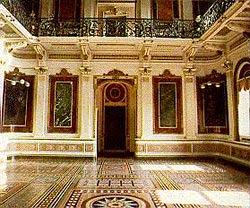
The Indian Treaty Room. This two-story room has seen the signing of international treaties, press conferences, and presidential ceremonies. The bronze lamps in each corner represent for Peace Prepare for War, Liberty, Sciences and Industry, 1991. Joyce Naltchayan. |


